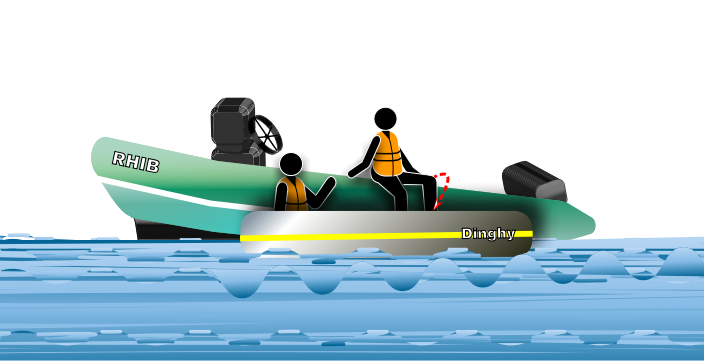In its latest Safety Digest, UK MAIB analyzed a man overboard fatality, involving the transfer of an individual from a moored RHIB to a small inflatable dinghy. MAIB stressed that the two people onboard routinely wore lifejackets when they took the RHIB to sea, but did not wear them when rowing to the mooring to bail the boat.
The incident
The owner of a RHIB and a friend rowed a small inflatable dinghy out to the moored RHIB to bail out rain water.
It was a blustery afternoon so both men were wearing warm clothing, waterproof jackets and wellington boots; neither man was wearing a lifejacket or buoyancy aid.
On arrival, they tied the dinghy to the RHIB and climbed onboard. Once the RHIB’s bilges were dry, the owner climbed back into the dinghy.
He then untied the dinghy and held it alongside to allow his friend to board.
While stepping between the two boats the owner’s friend slipped and fell into the water, taking one of the dinghy’s oars with him. The fall caused the owner to lose his grip on the RHIB.
Once adrift, the dinghy was blown quickly towards the shore and came to rest on a patch of kelp.
The RHIB owner’s friend started to swim towards the dinghy but after a couple of minutes his head disappeared below the surface.
The owner could see his friend lying face-down in the water but was unable to row to him through the wind using the one remaining oar.
The owner tried to raise the alarm by shouting and waving his arms to attract the attention of those on shore.
After several minutes, the owner attracted the attention of a passing delivery van driver and a local doctor.
The van driver ran to the water’s edge, and without hesitation swam out to the casualty and pulled him ashore.
Once the casualty had been recovered onto the beach the driver and doctor attempted to resuscitate him. Despite their extensive efforts he could not be revived.
Lessons learned
- The difficulty of trying to swim in cold sea water without the support of a buoyancy aid or lifejacket cannot be over emphasised. The owner and his friend routinely wore lifejackets when they took the RHIB to sea but did not wear them when rowing to the mooring to bail the boat. The risk of falling overboard when transferring from boat to boat is high and therefore it is essential that buoyancy aids and lifejackets are always worn.
- Stepping between boats is always hazardous. In this case, the owner’s friend attempted to step from one boat to the other, across both flotation tubes, wearing wellington boots. Had the friend lowered his centre of gravity by sitting on the RHIB’s side tube, holding on to a lifeline, swinging first his legs and then his body into the dinghy, he would have remained in control of his movement throughout, significantly reducing the risk of his falling overboard. Similarly, had suitable non-slip footwear been worn, the risk of slipping would have been reduced.
- Once the owner realised that he could not get to his friend there was little he could do without risking his own life. In this case, the carriage of a rescue throw line in the dinghy might have helped.
- The owner struggled to raise the alarm. The carriage of a portable VHF radio or even a whistle in this case would have helped.






























































